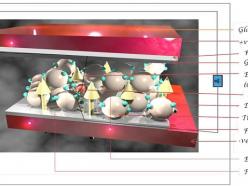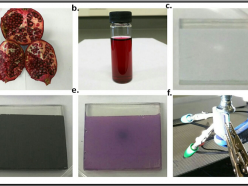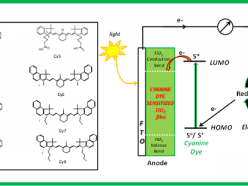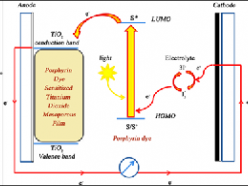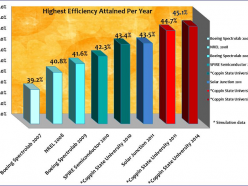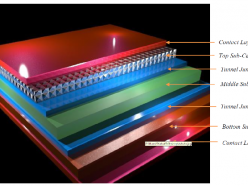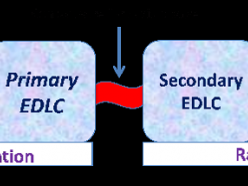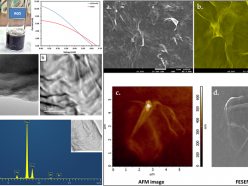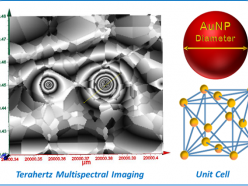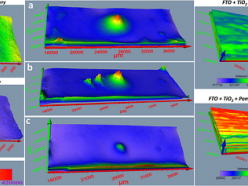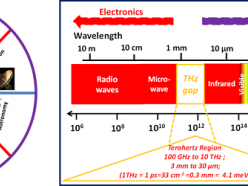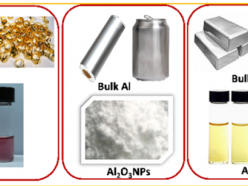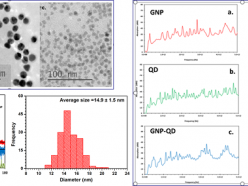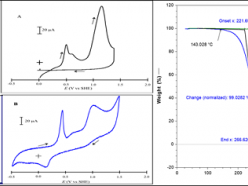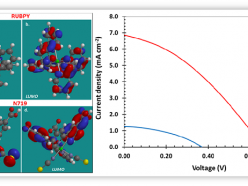Center for Nanotechnology
Nanotechnology Research
The Center for Nanotechnology in the Natural Science Department at Coppin State University is involved in innovation work on a number of fronts including dye sensitized solar cell studies, Gold nanaparticle work, and Terahertz Spectroscopy.
Dye Sensitized Solar Cell Research
Firstly, the center is actively engaged in cutting-edge dye sensitized solar cell research. Dye sensitized solar cells are third generation solar cells that are fabricated from simple materials and are generally less expensive and environmentally friendly. In this research effort, different organic and synthetic dyes are being used to harness solar energy for the production of electricity. The nanotechnology center is equipped with the state-of-the-art instrumentation such as solar simulator, potentiostat, and a spin coater which are very critical to the advancement of this particular type of research.
Different projects involving different components of dye sensitized solar cells have been carried out to improve the efficiency of solar cells. The following are examples:
Fabrication, Optimization and Characterization of Natural Dye Sensitized Solar Cell
The dyes extracted from pomegranate and berry fruits were successfully used in the fabrication of natural dye sensitized solar cells (NDSSC). The morphology, porosity, surface roughness, thickness, absorption and emission characteristics of the pomegranate dye sensitized photo-anode were studied using various analytical techniques including FESEM, EDS, TEM, AFM, FTIR, Raman, Fluorescence and Absorption Spectroscopy. Pomegranate dye extract has been shown to contain anthocyanin which is an excellent light harvesting pigment needed for the generation of charge carriers for the production of electricity. The solar cell’s photovoltic performance in terms of efficiency, voltage, and current was tested with a standard illumination of air-mass 1.5 global (AM 1.5 G) having an irradiance of 100 mW/cm2. After optimization of the photo-anode and counter electrode, a photoelectric conversion efficiency (η) of 2%, an open-circuit voltage (Voc) of 0.39 mV, and a short-circuit current density (Isc) of 12.2 mA/cm2were obtained. Impedance determination showed a relatively low charge-transfer resistance (17.44 Ω) and a long lifetime, signifying a reduction in recombination losses. The relatively enhanced efficiency is attributable in part to the use of a highly concentrated pomegranate dye, graphite counter electrode and TiCl4 treatment of the photo-anode.
Photophysical properties of near-IR cyanine dyes and their application as photosensitizers in dye sensitized solar cells
Eight heptamethine cyanine dyes were synthesized and investigated for application in dye sensitized solar cell. The photophysical properties of the dyes revealed differences in optical properties with respect to their structure. The performance of the cyanine dye-sensitized solar cells conformed to the photophysical properties of the cyanine dyes.
Photophysical, Electrochemical and Photovoltaic Properties of Porphyrin-Based Dye Sensitized Solar Cell
ABSTRACT
Porphyrins occur in a number of important biomolecules and are also synthetically made for use as probe component of chemical and biological sensors. The performance of dye sensitized solar cells with two different porphyrin dyes was investigated in this work. The two porphyrin complexes comprised of a metal-free 5, 10, 15, 20-meso-tetrakis-(9H-2-fluorene-yl) porphyrin (H2TFP) and its Zinc complex (ZnTFP). UV-Vis, Fluorescence, and Fourier transformed infrared measurements of the two dyes were carried out to evaluate their absorption, emission and binding characteristics. Both dyes absorbed light in the UV-visible region all the way to the near-infrared. The surface morphology and elemental analysis of the porphyrin dye sensitized photoanodes were determined using Field Emission Scanning Electron Microscopy Imaging and Transmission Electron Microscopy Imaging. Cyclic voltammetry studies, current-voltage characteristics and the electrochemical impedance spectroscopic studies were also carried out. Solar-to-electric energy efficiency of H2TFP dye sensitized solar cell was higher (0.11%) than that of the zinc complex (0.08%). Thus the metal free porphyrin generated more power than the zinc complex under similar conditions. The impedance measurement also displayed less overall resistance for the free porphyrin (50 Ω) compared with the zinc complex (130 Ω). The LUMO levels of H2TFP and ZnTFP sensitizers were −0.87 eV and −0.77 eV respectively. Both of these LUMO values are higher than the lower bound level of the conduction band of TiO2 (−4.0 eV), ensuring the efficient injection of an electron from the excited porphyrin dye to the conduction band of the titanium dioxide.
Synthesis and Characterization of Free and Copper (II) Complex of N,N′-Bis(Salicylidene)Ethylenediamine for Application in Dye Sensitized Solar Cells
ABSTRACT
Dye sensitized solar cell represents a promising method for the conversion of solar energy to electric energy. In the present work free N,N'-bis(salicyli-dene)ethylenediamine and its copper (II) complex were synthesized, characterized, and investigated for use as dye sensitizers in the fabrication of dye sensitized solar cells. The dyes were characterized using UV-Vis, Steady State Florescence, and Fluorescence Lifetime, Thermogravimetric Analysis, Differential Scanning Calorimetry, and Cyclic Voltammetry. The thermogravimetric analyses of the ligand and the ligand Copper complex demonstrate the stabilizing effect of the copper ion on the ligand complex. Additionally, the copper ion is shown to stabilize the structure, as evidenced by the 150oC increase in the extrapolated onset temperature of the decomposition event. The ligand copper complex is further stabilized by the presence of the copper, which is determined by the 6.34% residue that remained at the end of the thermogravimetric analysis, compared with 0% residue when applying the same condition for the ligand without copper. The current-voltage characteristics of the cells and the electrochemical impedance were determined. The photovoltaic performance of the solar cell devices fabricated using N,N'-bis(salicylidene) ethylenediamine dye was found to be slightly better than those produced from the copper complex. The solar to electric power efficiency of the ligand-based dye sensitized solar cell was 0.14% and that of the copper complex was found to 0.12%. Although the difference in the cell efficiency is quite small, it is obvious that the insertion of Copper into the ligand did not enhance the performance of the solar cells. The photocurrent-photovoltage results are consistent with the absorption spectra that showed a more prominent band for the ligand. The free hydroxyl groups, present in the ligand but absent from the copper complex owing to their coordination with the copper metal, could be responsible for the difference in the performance of the devices. The hydroxyl groups get attached to the TiO2 and facilitate the transfer of electrons.
Comparison of the Performance of Dye Sensitized Solar Cells F abricated with Ruthenium Based Dye Sensitizers: Di-tetrabutylammonium cis-bis(isothiocyanato)bis(2,2’-bipyridyl-4,4’-dicarboxylato)Ruthenium(II) (N719) and Tris(bipyridine)Ruthenium(II) Chloride(Rubpy)
The photovoltaic performance of two ruthenium based dyes was measured and compared to assess the effect of anchoring groups on the current-voltage characteristics of dye sensitized solar cells. One of the two dyes, Di-tetrabutylammonium cis-bis(isothiocyanato)bis(2,2’-bipyridyl-4,4’-dicarboxylato)ruthenium(II), (N719) had an anchoring group - and the other, Tris(bipyridine)ruthenium(II) chloride (Rubpy), without an anchoring group. N719 showed a higher efficiency compared to Rubpy. The results were validated by density functional calculation.
Terahertz Research
Terahertz radiation, also known as “terahertz gap” is the frequency band (~0.1 THz to ~ 10 THz) sandwiched between the far infrared and microwave region of the electromagnetic spectrum. Terahertz radiation stimulates various resonances when they interact with different types of materials producing signals characteristic of the specific interaction between the radiation and the material. Until recently, terahertz technology received very little attention due to the difficulty in accessing, manipulating and detecting the radiation. New advances in technology, over the past couple of decades, have opened the door for an efficient and cost effective means of generating and detecting terahertz radiation. Terahertz spectroscopy is complementary to techniques such as Raman and infrared spectroscopy. The radiation is invisible, low energy, non-ionizing, noninvasive, and comparatively transparent to many materials with few exceptions such metals and liquid water. These properties make it safe and suitable for use in a myriad of application including the analysis of biological structures in their native state. Current applications of Terahertz include Spectroscopic analysis, imaging, material characterization, pharmaceutical product analysis, detection of concealed weapons, detection of diseases, and general inspection of products.
Terahertz Technology Research in Dye Sensitized Solar Cells (DSSC)
Another leading-edge research effort involves the use of terahertz radiation for the characterization of a variety of materials, chief among them being semiconductor devices. Terahertz radiation is in a region of the electromagnetic spectrum between infrared and microwave. Until recently, research involving terahertz radiation has been minimal due to the lack of sources for the generation and detection of the radiation. Recent discovery of sources for terahertz generation and detection has spurred innovative work in this area of research. Terahertz has the potential for biological analysis and also for security screening at airports and other restricted locations because they are able to generate images while being non-ionizing and less hazardous compared to X-rays. We have used Terahertz radiation to characterize semiconductor materials and the photoanode component of dye sensitized solar cells.
Terahertz Technology Research with gold nanoparticles Research
In this work, we are investigating the use of a Terahertz multispectral reconstructive imaging technique to measure the size of individual gold nanoparticles and accordingly the number of unit cells in a given gold nanoparticle. Terahertz multispectral reconstructive imaging technique was used to measure the diameter of individual gold nanoparticles and by extension the number of unit cells and gold atoms in a given gold nanoparticle. The size as determined by Terahertz imaging was comparable, within limit of experimental error, to the size determined via Transmission electron microscopy. Terahertz radiation is non-ionizing and terahertz imaging instrumentation less expensive compared withelectron microscopes.
Energy Storage and its Application in Transportation
"The Solar Light Rail" is a proposed power supply method for a 100% renewable energy light rail system. A prototype model experimentation was carried out and confirmed that the proposed power supply method was effective.
Synthesis and Characterization of Reduced Graphene Oxide and their Application in Dye Sensitized Solar Cells
Reduced graphene oxide has certain unique qualities that make them versatile for a myriad of applications. Unlike graphene oxide, reduced graphene oxide, is a conductive material and well suited for use in electrically conductive materials such as solar cell devices. In this study we report on the synthesis of graphene oxide as well as the fabrication and characterization of dye sensitized solar cell with a photoanode which is an amalgam of reduced graphene oxide and titanium dioxide. The synthesized reduced graphene oxide and the corresponding photoanode were fully characterized using ultraviolet-visible, Fourier transform infrared (FTIR) and Raman Spectrometry. The morphology of the sample was assessed using Atomic Force Microscopy, Field Emission Scanning Electron Microscopy, and Transmission Electron Microscopy and Energy dispersive X-ray spectroscopy. The photovoltaic characteristics were determined by photocurrent and photovoltage measurement of the solar cell. The electrical impedance of both sets of devices were also evaluated. Overall, the solar to electric power efficiency of the device with reduced graphene oxide was higher (2.02%) than the sample without the reduced graphene oxide (1.61%).
Simulated Multi-junction Solar Cell
Photovoltaic technology is an important source of alternative energy. Researchers at Coppin State University have managed to simulate high-efficiency solar cells using a multi-junction design.
Research work at the center for nanotechnology resulted in production of most efficient simulated multi-junction solar cell
Gold Nanoparticle Research
The center is also involved in nanoparticle research. New methods have been developed at the center for the size analysis of gold nanoparticles. Gold nanoparticles have also been synthesized and used for energy transfer studies. Another innovative work with nanoparticles involves their use as a contrast agent for imaging studies of heart disease and cancer. These gold nanoparticles are also being conjugated to MRI contrast agents such as gadolinium chelates and fluorophores such as indocyanine green for MRI and fluorescence imaging, respectively. Brand-new instrumentation such as Transmission Electron Microscope, Scanning Electron Microscope, Atomic Force Microscope, Absorption and Emission Spectrophotometers have facilitated the work at the center.
Terahertz spectroscopic studies of quantum dots-conjugated gold nanoparticles
Composite structures of metal nanoparticles and semiconductor nanomaterials present unique properties that have made them candidates for various applications. The properties of these hybrid structures to a large extent depend on the design and specific material used in to produce them. Here, we present work on the synthesis and characterization of CdSeS/ZnS quantum-dot–gold nanoparticles hybrids (denoted as QD-GNP) and studies on their interaction with terahertz radiation. The prepared QD-GNPs were characterized using UV-vis spectroscopy (UV-vis), Dynamic Light Scattering (DLS), Transmission Electron Microscopy (TEM), Fluorescence Spectrometry and Photoluminescence Lifetime measurement. The wavelength of maximum absorption of the gold nanoparticles was 520 nm while that of the quantum dot was 609 nm. The peak absorption band of the hybrid solution was around 520 nm. Transmission electron microscopy imaging revealed the surface morphological features of the quantum dot and gold nanoparticle. Strong photoluminescence quenching was observed upon the conjugation of the quantum dots with gold nanoparticles. The observed difference in the lifetime of free quantum dot and the hybrid QD-GNP was an indication of the bonding between the quantum dot and gold nanoparticles. A biexponential decay was observed with a lifetime of 3.57 ns for bare quantum dots and 1.05 ns for QD-GNP as for the faster component and the slower component 15.09 ns and 8.30 ns QD AND QD-GNP, respectively. Unique features were observed on the terahertz spectra of the composite structures in comparison with that of the either the QD or the GNP
Contact Us
Thank you for your interest in the Center for Nanotechnology at Coppin State University. We welcome any questions and feedback you have. If you would like more information on anything you have read about our Center for Nanotechnology, please reach out to the following people:
